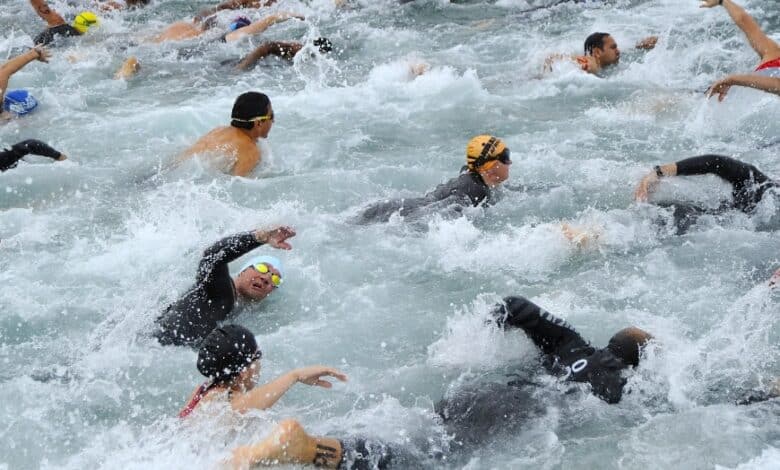Psychology of swimming in triathlon: Overcoming overwhelm and stress in competition

Swimming in a triathlon can be challenging, especially due to the proximity of other competitors, the possibility of disorientation, and physical incidents such as bumps or swallowing water.
This article focuses on how triathletes can mentally prepare to face and overcome these situations.
1- Facing Congestion and Physical Contact
Swimming in a group can generate anxiety and stress. It is crucial to develop strategies to stay calm in the midst of chaos.
Techniques such as visualization of high-density swimmer situations and breathing exercises can be helpful.
Additionally, training under similar conditions can help athletes get used to close proximity and physical contact.
These are some examples that may help you:
Group Training
Practice swimming in a controlled environment with a group of people. This helps you get used to the proximity of other swimmers and learn to maintain your own line and pace.
Read this article from “Group swimming exercises” for examples of how to do it
Controlled Breathing Techniques
Learn to control breathing under stress. Exercises such as deep, controlled breathing can help you stay calm and reduce anxiety in high-density swimmer situations.
Endurance and Resistance Exercises
Strengthen physical and mental endurance through specific exercises that mimic competition conditions, such as swimming with soft obstacles to simulate contact with other swimmers.
2-Management of Disorientation and Loss of Direction
Disorientation is a common challenge in triathlon swimming. Practicing open water orienteering and learning to use visual references can be a great help.
Additionally, concentration and focus techniques can help you stay on track and avoid wasting time and energy.
We give you 3 techniques for you to practice in your training.
Orientation with Reference Points
Practice swimming in open water using fixed reference points (such as buoys, shoreline buildings, etc.) to improve the ability to maintain a constant direction.
“Sighting” Technique
Learn and regularly practice the spotting technique, which involves raising your head briefly to orient yourself, without significantly altering your swimming rhythm.
You can do this in pool training sessions.
Competition simulations
Create a swimming course that mimics competition conditions, including turns and changes of direction, to improve navigation and orientation in the water.
You may be interested in reading How to orient and swim in a straight line in open water?
3- Overcoming Fear and Panic After Swallowing Water
Accidentally swallowing water can cause panic. It is important to train the mind to remain calm and recover quickly from these incidents.
Practicing self-control techniques and gradual exposure to similar situations in training can increase confidence and resilience.
Rapid Recovery Techniques
Practice immediate recovery after swallowing water, such as learning to cough efficiently while staying afloat and regaining your breathing rhythm.
Mental Self-Control Training
Meditation and visualization exercises to prepare the mind to react calmly in stressful situations, such as accidentally swallowing water.
Practice in conditions similar to those of the competition
Train in conditions that can simulate swallowing water, such as swimming in rougher water or performing swimming exercises immediately after submerging, to get used to the sensation and learn to manage it.
If you want to continue going deeper, we recommend reading this article Mental and physical training for open water
In conclusion, facing stress in triathlon swimming requires both physical and mental preparation.
Relaxation techniques, visualization, training in real conditions and advice from experienced athletes are essential to overcome these challenges.
There are no previous results.




























